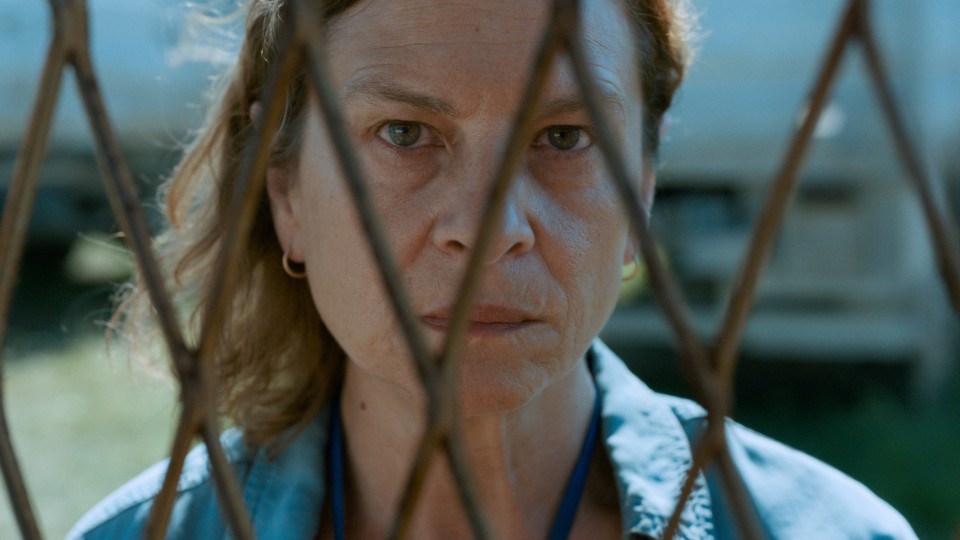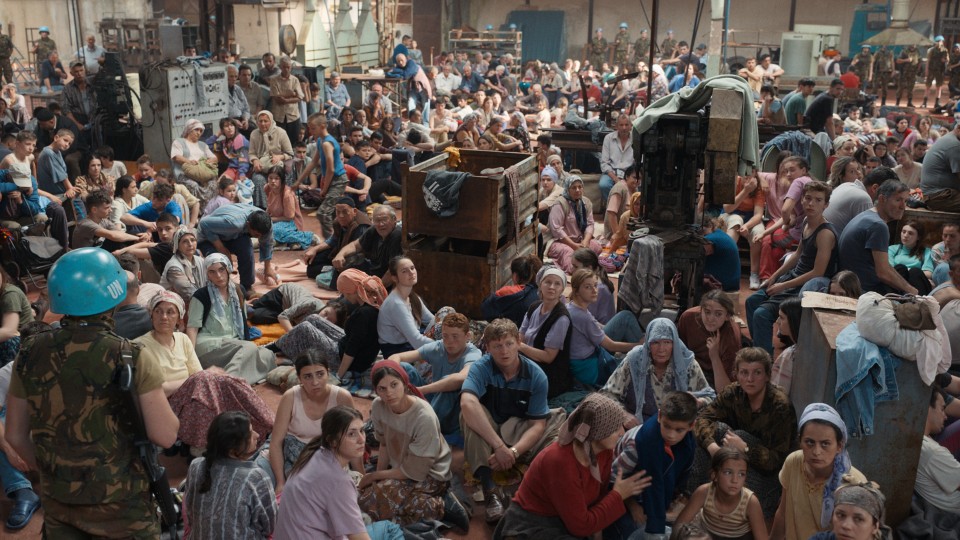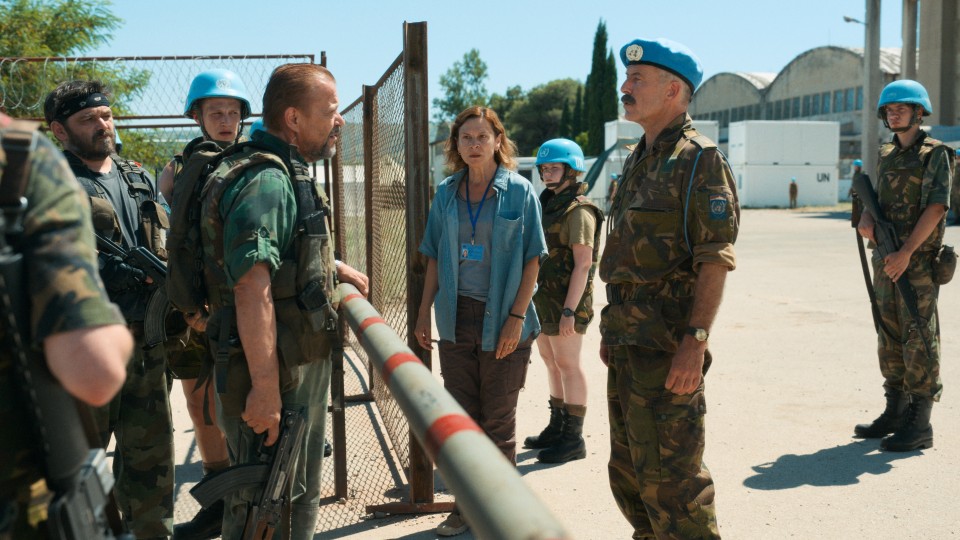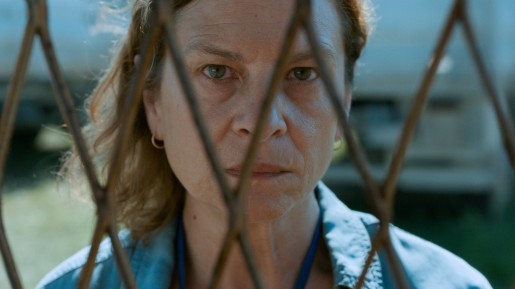July 1995, Srebrenica. General Mladic sweeps to power, the UN mission fails miserably. UN interpreter Aïda is obliged to
watch helplessly as a tragedy of unimaginable proportions befalls the city and her family within one day. Filmmaker Jasmila
Žbanić, originally from Bosnia, plunges into the epicentre of this crime against humanity in QUO VADIS, AÏDA?, 25 years after
the mass murder at Srebrenica, when betrayal and failure led to the deaths of thousands of people. She depicts the terrible
force of the collective drama as it strikes each individual character in the film. Vienna-based coop99 filmproduktion is one
of the international co-producers on this project, which will be among the 18 competitors for the Golden Lion at the 77th Venice Film Festival. A conversation with the DoP of QUO VADIS, AÏDA?, Christine A. Maier.
A glance at the IMDb reveals that QUO VADIS, AÏDA? is the 10th time you have worked with Jasmila Žbanić, including feature films, documentaries, short films and individual episodes. It
is your most consistent and longest-lasting artistic partnership. How and under what conditions did this collaboration originate?
CHRISTINE A. MAIER: The first time we met was by chance
or perhaps not. In 1995, together with Maria Arlamovsky and Barbara Albert, I was one
of the organisers of the Student Film Festival at the Vienna Film Academy. We were so shocked by what was happening just 400
kilometers away that we decided to create a focus on Bosnia within the festival, and we invited all contributions from the
Sarajevo Film School. We attempted to bring films and students from Sarajevo to Vienna, although we only succeeded with a
handful of films, by a very roundabout route. But because of the Dayton Agreement it was possible for us to go to Bosnia.
Nikolaus Geyrhalter had just started research for his film The Year after Dayton, and Barbara Albert wanted to carry out research for Nordrand, so we all went to Bosnia. We collected material, films, books, camera and film stock for the film school there, and then
we packed everything into the car and drove to Bosnia with Nikolaus. It was the strangest journey of my life. When we arrived
in Sarajevo after a 40-hour drive Jasmila was the first person we met. She invited Barbara and me to stay with her and put
us up for 10 nights in her mother's apartment, on the couch in the living room. Barbara and I filmed Somewhere Else with a little High 8 camera we‘d brought with us just in case something turned up. Jasmila is one of our protagonists. That
was the beginning of our friendship, and we've been in touch constantly ever since. We started out making short films, and
since then hardly a year has passed without my going to Sarajevo. I have come to feel a very strong bond with the city.
The late 1990s was also the period when Barbara Albert made Nordrand, which has a connection to Sarajevo as well. To what extent did the fate of the former Yugoslavia determine the beginning
of your creative career, and does it still have that influence?
CHRISTINE A. MAIER: When the war in Yugoslavia broke out I was still studying Law. It was a stage in my life which had a decisive influence on
my perspective of the world and my way of thinking. Something that everyone thought could never happen again was actually
taking place in the next country. The place where I grew up is about 50 km from the border with Slovenia. That had a powerful
influence on me, and the events still preoccupy me to this day. Political interest is one thing, but personal involvement
is completely different. If Barbara and I hadn't met Jasmila back then, perhaps the effect wouldn't have been so intense,
and it almost certainly wouldn't have lasted as long as it has.
What links you to Jasmila Žbanić on an artistic level?
CHRISTINE A. MAIER: We share a powerful sense of curiosity. Jasmila is somebody who always tries to think about things differently. We enjoy
spending time together, and we keep in touch all the time. There is a strong sense of mutual understanding and trust. I see
Jasmila as an exceptionally brave and uncompromising person, and everything about that fascinates me – in artistic matters
as well. The approach she adopts towards her work varies a great deal. Sometimes things come into being virtually overnight,
like One Day in Sarajevo, where there were only two weeks between the idea and starting to film in the collective; the form that emerged in that way
was exactly right for that essay film, because it all automatically became provocative about "the great narrative" on the
100 year anniversary of the assassination in Sarajevo. In contrast, QUO VADIS, AÏDA? was a project which took a very long
time before filming began. I'm usually involved in the projects at a very early stage, and with QUO VADIS, AÏDA? I was also
familiar with all the phases of the script, which still underwent a fundamental change at the last minute. And that was just
one of many obstacles that had to be overcome during the long preparatory phase. In recent years Jasmila has spent more time
living in Berlin, which is certainly also a way of achieving the distance required to write the screenplay.
When Jasmila Žbanić won the Golden Bear at the 2006 Berlin Film Festival with Grbrvica it meant she reached a wide international audience with the subject that so concerns her: the war and its consequences. What
do you think motivates Jasmila in her creative work? In QUO VADIS, AÏDA? is she not only venturing into one of the most painful
and horrific areas of recent Bosnian history but also, more than in her other films, including collective experience as well
as individual stories?
CHRISTINE A. MAIER: Jasmila was well aware that making a film about the genocide in Srebrenica, the central theme of QUO VADIS, AÏDA?, is a huge
gamble and an immense narrative challenge. She spent years researching the subject, and from the very start it was obvious
that it wouldn't be possible to do justice completely to the whole breadth and dimension of those events in a feature film.
But she couldn't let go of the subject. Her central question was always how to bring the emotions and dilemmas of the people
who experienced the genocide to an audience that perhaps knows little about Srebrenica and, above all, what does it say to
us about our lives today? She decided to tell the story through a main protagonist, Aïda, who is an interpreter for the United
Nations. Her husband and their two sons are among the refugees who seek shelter and protection in the UN compound. Because
of her work for the UN, she moves between the two worlds. We always attempted to present the individual and collective levels
of the events in the film without separating them, so the dimension of what happened can at least be felt. The main section
of the film concentrates on the events of those three days in the UN compound, where 5,000 refugees within the UN zone and
25,000 refugees outside the zone came for shelter. That was important to us, especially in relation to the big scenes with
so many extras. We didn't want to present faceless crowds but people who – just like Aïda and her family – have their own
individual fates. Casting the scenes with all those extras was a particularly elaborate process, and Luna Mijović – who acted
in Grbrvica – was very closely involved in the search. Jasmila and Luna wrote life stories for many of the extras, which they were given
before shooting began.
It sounds as though shooting QUO VADIS, AÏDA? was more than just a typical film shoot?
CHRISTINE A. MAIER: It was an extraordinary film for everybody involved. I think every member of the crew would confirm that: the situation,
the subject, the locations in Mostar and Stolac – which also have their own stories – the unusual heat, the fact that we were
a team composed of people from 9 or 10 nations. Some of us hadn’t met before, there were so many different languages on the
set, and yet we were one entity. I'd never experienced that before. The tension, the atmosphere all round us. We were welcomed
there with great hospitality, but at the same time what happened 25 years ago was always in the air. Nobody could get away
from that. It was an intense emotional experience of the sort you have very rarely.
Another fundamental issue seems to have been the extent to which atrocities should be shown explicitly or just implied. To
what extent was this question also linked with a tendency to look away, rather than see what was actually happening, on the
part of the people commissioned by the United Nations to protect the people who were massacred?
CHRISTINE A. MAIER: We attempted to show as little explicit violence as possible. Usually we see the situation immediately before or afterwards.
That was one of our premises, which we adhered to from the very beginning, but it wasn't so much connected with the issue
of whether the UN saw what was happening or looked away; we were concerned with the effect violence has on someone’s life,
and I don't need to see the moment of violence for that.
In view of the measures taken to combat the Coronavirus, what were the last weeks of postproduction like before the upcoming
world premiere in Venice?
CHRISTINE A. MAIER: We had planned to do postproduction in Romania, and thank God we were there in February and did some grading in advance.
Then Corona came along, flights were cancelled, and quarantine measures were imposed in both directions. Light grading that
would normally take three days would have taken two weeks of work, and if we were unlucky there wouldn't have been any return
flights either. To resolve the problem we networked two studios and at the same time started work on colour grading. But although
the projectors are calibrated well, one projection is 2K and the other is 4K, and the screens are different sizes. On the
big screen in Berlin I can see things that the colour grader in Bucharest might see differently on the small screen there.
You can't describe colours and contrast so precisely, and you can never be sure the other person sees the same thing you do.
Everything that is normally simple in the production process suddenly takes three times as long, because you always have to
calculate waiting times as well. Mixing had to be done remotely too. The mixing was performed in Bucharest, the sound designer
was in his studio in Sarajevo, and Jasmila was in a studio in Berlin. It was a completely new experience for all of us.
Interview: Karin Schiefer
August 2020
Translation: Charles Osborne






